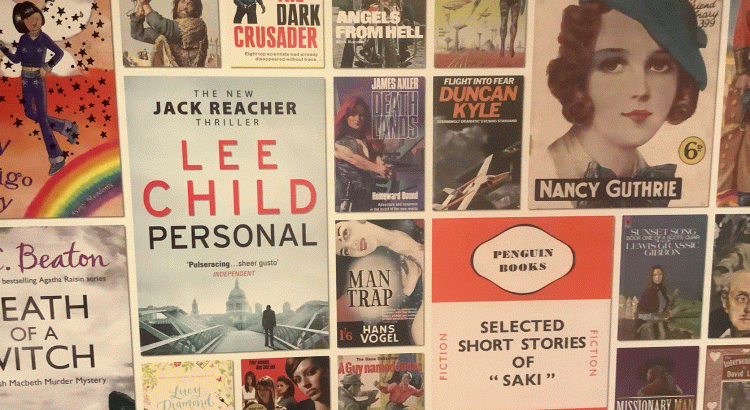A pen name is a literary alias: a variation of a writer’s birth or married name or a completely invented pseudonym. The Library’s exhibition ‘Pen Names’ takes a thematic approach to the subject, looking at how factors such as privacy, gender, reputation, authenticity, and genre have influenced writers’ decision to use a pen name from the 1800s to the present day. This blog is a brief look at how ideas of authorship have evolved over time and how publishing anonymously and pseudonymously became an established literary convention in British literature.
In the Classical world literary fame was regarded as a desirable thing by most authors. The names and works of Virgil and Aristophanes have far outlasted the civilisations in which they lived. Views on worldly fame changed when Christianity spread through Europe. Writers were now more likely to think of themselves as mere scribes and the authorship of many works such as ‘Beowulf’ is unknown, and the oral tradition was still to a great extent dominant. The early modern period (roughly 1500 to 1800) was a period of greater individualism and also when the idea of literary copyright came into being. Writers could now earn a living from their work. William Shakespeare’s name became what we would now call a brand and appeared on his plays as it helped sales. Many works though were published anonymously or attributed to ‘a lady,’ or ‘a clergyman’.
The 19th century is the period where our exhibition begins and when literature starts to resemble a masked ball, with many authors choosing to hide their identities. By 1830 around 80% of novels were issued under a pen name or were anonymous. Printers were obliged by law to put their name on the title page of a book, and it was suggested that the law should be extended to make authors publish under their ‘real’ names, but this never happened.
Pen names became part of the literary landscape, especially as female novelists had become a force in literature. Women were more likely to publish under a pen name or anonymously due to their position in society and fears their work would be judged more harshly because of their gender. The Brontë sisters, for example, published under the names of Currer, Ellis and Acton Bell. Charlotte Brontë later explained the decision was because of “a vague impression that authoresses are liable to be looked on with prejudice”.
Some of the most famous male authors of the period also used pen names. William Thackeray (1811-1863) signed magazine contributions as Charles James Yellowplush, George Savage Fitz-Boodle and Michael Angelo Titmarsh. Charles Dickens (1812-1870) published his first book as Sketches by Boz, the pen name derived from the way Dickens pronounced Moses as a small child.
By the end of the 19th century literature by women was popular and lucrative which might explain why Scottish writer William Sharp (1855-1905) chose in the 1890s to publish several novels as Fiona Macleod. Sharp’s motivations though were complex and remain obscure. He maintained that Macleod was a cousin, and it seems possible that Sharp believed she existed. The fictional Macleod even had an entry in ‘Who’s Who’.
In the 20th and 21st centuries the authors behind most pen names are known. If you look at the author information on the historical crime novels attributed to Ambrose Parry you will see a photograph and the details of the authors Chris Brookmyre and Marisa Haetzman.
Pen names are now as much a marketing tool to guide readers towards books as a mask for authors. Research by Nielsen in 2021 revealed that for the top ten bestselling female authors in the UK only 19% of their readers are men, 81% are women. Men seem reluctant to pick up novels written by women. The female author with the largest male readership was crime writer L.J. Ross who hides her name Louise (and thus her gender) behind initials. In 2012 the historical novelist Shona MacLean was advised to publish future books as S.G. MacLean. Her publisher thought her name was too soft and feminine and might put male readers off. For similar reasons Bloomsbury suggested the Harry Potter novels should be published as by J.K. Rowling, not Joanne Rowling.
When Iain Blair (1942-2011) had little success writing thrillers he switched to writing romance. It was suggested that his romantic novels might sell better if they were published under a woman’s name and so they appeared under the pen name Emma Blair. His wife Jane commented, “Emma was not the quiet, retiring type but a 6ft 3in Glaswegian called Iain Blair who enjoyed a pint and a smoke”. Emma was revealed to be Iain in 1998 when ‘Flower of Scotland’ was nominated for the Romantic Novel of the Year Award.
In the 21st century writers can no longer hide in their garrets; they must go out in the world and appear on the media and at book festivals. The potential for hiding behind a pen name, especially if it does not tie in with your gender or appearance is limited. The literary tradition of pen names though continues. Two of the bestselling authors of this century are E.L. James and Lee Child, both are pen names.
You will find E.L. James, Lee Child, Currer, Ellis and Acton Bell, and Fiona Macleod in the exhibition, You will also find Lewis Carroll, George Eliot, Lewis Grassic Gibbon, James Herriot, Rebecca West, and many other authors who chose to publish under pen names. The exhibition features book and manuscript items from our collections.
The library’s exhibition Pen Names explores a range of writers working in Britain from the 1800s to the present day who use pen names. The exhibition runs from 8 July 2022 to 29 April 2023. For more information see here. For more blog posts about authors who use aliases search #PenNamesNLS.
